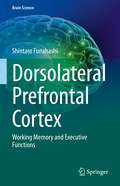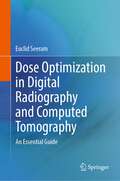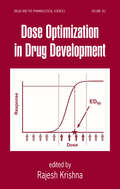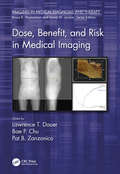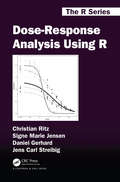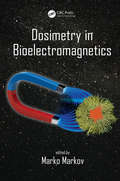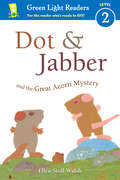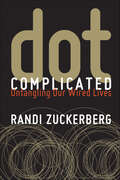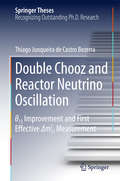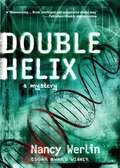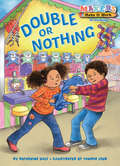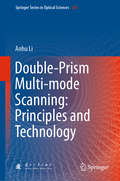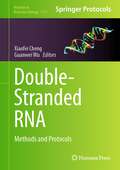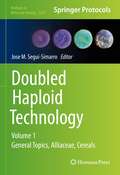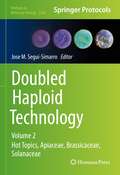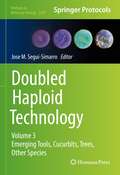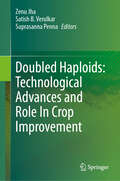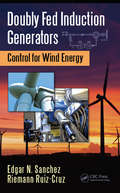- Table View
- List View
Dorsolateral Prefrontal Cortex: Working Memory and Executive Functions (Brain Science)
by Shintaro FunahashiThe prefrontal cortex is known to play important roles for performing a variety of higher cognitive functions. Among regions of the prefrontal cortex, the dorsolateral prefrontal cortex plays the most important roles for these functions. This book focuses on functions of the dorsolateral prefrontal cortex, summarizes research results obtained mainly by non-human primate studies, and describes neural mechanisms of executive functions that the dorsolateral prefrontal cortex participates. First, to understand the feature of the dorsolateral prefrontal cortex and how its function has been understood, anatomical and functional features of the dorsolateral prefrontal cortex and historical overview of prefrontal functions are described. To understand functions of the prefrontal cortex and neural mechanisms of executive functions, working memory is an important concept and sustained activation during the memory period of working memory tasks is known as a neural mechanism of working memory. Therefore, this book describes features of sustained memory-related activity based on neurophysiological results obtained in the prefrontal cortex and how memory-related activity contributes to executive functions including control of attention, inhibitory control, task management, and planning. And further, this book describes how the dorsolateral prefrontal cortex contributes to neural mechanisms for sensory and motor processing, memory control in multi-task performance, decision-making, metacognition, and top-down control. Thus, this book provides important information regarding neural mechanisms of dorsolateral prefrontal functions to neuroscientists and helps to plan further investigation to understand prefrontal functions in primates and human subjects.
Dose Optimization in Digital Radiography and Computed Tomography: An Essential Guide
by Euclid SeeramThis book addresses radiation protection of patients having digital radiography and computed tomography (CT) examinations. The literature on radiation doses to patients from these two modalities have reported that the doses to patients are high. As a result, the radiology community has focused on methods and procedures to keep these doses as low as reasonably achievable (ALARA) without compromising the diagnostic image quality. This book outlines the motivation for dose optimization in radiology, identifies and describes the ICRP principle of optimization, outlines the factors affecting the dose in digital radiography and in CT, and identifies and describes strategies used in digital radiography and in CT for dose optimization.This book is intended for all those working in digital radiography and CT environments including radiological technologists, and radiographers, radiologists, biomedical engineering technologists, and student medical physicists. It is best used as a supplement to radiologic science textbooks, and in particular, radiation protection textbooks. Furthermore, this book lays the foundations for students and practitioners engaged in research on dose reduction and dose optimization in radiology.· Provides practical and useful methods for optimization of doses from digital radiography and CT · Describes the International Commission on Radiological Protection (ICRP) principle of optimization · Outlines the factors affecting the dose in digital radiography and in computed tomography
Dose Optimization in Drug Development (Drugs and the Pharmaceutical Sciences)
by Rajesh KrishnaThis reference provides a concise overview of the key principles in dose selection and optimization and demonstrates applicability to recent successful new drug applications. Compiling key issues and current research on safety, efficacy, and clinical pharmacology, and PK-PD, this volume critically highlights the multidisciplinary nature of drug dev
Dose, Benefit, and Risk in Medical Imaging (Imaging in Medical Diagnosis and Therapy)
by Lawrence T. Dauer Bae P. Chu Pat B. ZanzonicoThis timely overview of dose, benefit, and risk in medical imaging explains to readers how to apply this information for informed decision-making that improves patient outcomes. The chapters cover patient and physician perspectives, referral guidelines, appropriateness criteria, and quantifying medical imaging benefits. The authors have included essential discussion about radiologic physics in medical imaging, fundamentals of dose and image quality, risk assessment, and techniques for optimization and dose reduction. The book highlights practical implementation aspects with useful case studies and checklists for treatment planning. Clinicians, students, residents, and professionals in medical physics, biomedical engineering, radiology, oncology, and allied disciplines will find this book an essential resource with the following key features: Discusses risk, benefit, dose optimization, safety, regulation, radiological protection, and shared & informed decision-making. Covers regulatory oversight by government agencies, manufacturers, and societies. Highlights best practices for improving patient safety and outcomes. Gives guidelines on doses associated with specific procedures.
Dose-Finding Designs for Early-Phase Cancer Clinical Trials: A Brief Guidebook to Theory and Practice (SpringerBriefs in Statistics)
by Shigeyuki Matsui Akihiro Hirakawa Takashi DaimonThis book provides a comprehensive introduction to statistical methods for designing early phase dose-finding clinical trials. It will serve as a textbook or handbook for graduate students and practitioners in biostatistics and clinical investigators who are involved in designing, conducting, monitoring, and analyzing dose-finding trials. The book will also provide an overview of advanced topics and discussions in this field for the benefit of researchers in biostatistics and statistical science. Beginning with backgrounds and fundamental notions on dose finding in early phase clinical trials, the book then provides traditional and recent dose-finding designs of phase I trials for, e.g., cytotoxic agents in oncology, to evaluate toxicity outcome. Included are rule-based and model-based designs, such as 3 + 3 designs, accelerated titration designs, toxicity probability interval designs, continual reassessment method and related designs, and escalation overdose control designs. This book also covers more complex and updated dose-finding designs of phase I-II and I/II trials for cytotoxic agents, and cytostatic agents, focusing on both toxicity and efficacy outcomes, such as designs with covariates and drug combinations, maximum tolerated dose-schedule finding designs, and so on.
Dose-Response Analysis Using R (Chapman & Hall/CRC The R Series)
by Christian Ritz Signe Marie Jensen Daniel Gerhard Jens Carl StreibigNowadays the term dose-response is used in many different contexts and many different scientific disciplines including agriculture, biochemistry, chemistry, environmental sciences, genetics, pharmacology, plant sciences, toxicology, and zoology.In the 1940 and 1950s, dose-response analysis was intimately linked to evaluation of toxicity in terms of binary responses, such as immobility and mortality, with a limited number of doses of a toxic compound being compared to a control group (dose 0). Later, dose-response analysis has been extended to other types of data and to more complex experimental designs. Moreover, estimation of model parameters has undergone a dramatic change, from struggling with cumbersome manual operations and transformations with pen and paper to rapid calculations on any laptop. Advances in statistical software have fueled this development.Key Features: Provides a practical and comprehensive overview of dose-response analysis. Includes numerous real data examples to illustrate the methodology. R code is integrated into the text to give guidance on applying the methods. Written with minimal mathematics to be suitable for practitioners. Includes code and datasets on the book’s GitHub: https://github.com/DoseResponse. This book focuses on estimation and interpretation of entirely parametric nonlinear dose-response models using the powerful statistical environment R. Specifically, this book introduces dose-response analysis of continuous, binomial, count, multinomial, and event-time dose-response data. The statistical models used are partly special cases, partly extensions of nonlinear regression models, generalized linear and nonlinear regression models, and nonlinear mixed-effects models (for hierarchical dose-response data). Both simple and complex dose-response experiments will be analyzed.
Dosimetry in Bioelectromagnetics
by Marko MarkovDosimetry refers to the calculation and assessment of the radiation dose received by the human body. The proposed book will place emphasis on the existence of physical and biophysical dosimetry. It will be discussed for the proper description and evaluation of the signal at the power generation system. It will cover in detail 10 different parameters of EMF (electromagnetism) exposure such as amplitude, frequency, vector, time of exposure, orientation, etc. In most published papers, these parameters are not well defined.
Dot & Jabber and the Great Acorn Mystery (Dot & Jabber)
by Ellen Stoll WalshDot and Jabber are mouse detectives with a mission: They’re determined to find out how a little oak tree grew in their field when there are no other oak trees around. They know it grew from an acorn, but how did the acorn get there? Dot and Jabber have a case to crack--if Jabber doesn’t eat the clues first! Ellen Stoll Walsh, creator of the popular Mouse Paint mice, introduces two new mice who love mysteries. Full of curiosity and humor, Dot and Jabber track clues to solve science mysteries for young readers. An afterword presents easy-to-understand facts about acorns and oak trees.
Dot Complicated: Untangling Our Wired Lives
by Randi ZuckerbergWith Dot Complicated: Untangling Our Wired Lives, new media pioneer Randi Zuckerberg offers an entertaining and essential guide to understanding how technology and social media influence and inform our lives online and off.Zuckerberg has been on the frontline of the social media movement since Facebook’s early days and her following six years as a marketing executive for the company. Her part memoir, part how-to manual addresses issues of privacy, online presence, networking, etiquette, and the future of social change.
Dot.
by Randi Zuckerberg*NOW A HIT TV SERIES*Meet Dot in this debut picture book by CEO and founder of Zuckerberg Media, editor-in-chief of Dot Complicated, and former Marketing Director of Facebook, Randi Zuckerberg! Dot's a spunky little girl well versed in electronic devices—she’s a technophile. She knows how to tap . . . to swipe . . . to share . . . and she pays little attention to anything else.Dot's tech-savvy expertise, mingled with her resourceful imagination, proves Dot knows lots and lots.But will she be able to unplug for one second to tap…swipe…and share with her real-life friends? Find out in this wonderful story about the day when Dot sets off on an interactive adventure with the world surrounding her.
Double Chooz and Reactor Neutrino Oscillation
by Thiago Junqueira de Castro BezerraThis book is based on the author's work at the Double Chooz Experiment, from 2010 to 2013, the goal of which was to search for electronic anti-neutrino disappearance close to nuclear power plant facilities as a result of neutrino oscillation. Starting with a brief review of neutrino oscillation and the most important past experimental findings in this field, the author subsequently provides a full and detailed description of a neutrino detector, from simulation aspects to detection principles, as well as the data analysis procedure used to extract the oscillation parameters. The main results in this book are 1) an improvement on the mixing angle, θ13, uncertainty by combining two data-sets from neutrino event selection: neutron capture on gadolinium and on hydrogen; and 2) the first measurement of the effective squared mass difference by combining the current reactor neutrino experimental data from Daya Bay, Double Chooz and RENO and taking advantage of their different reactor-to-detector distances. The author explains how these methods of combining data can be used to estimate these two values. Each method results in the best possible sensitivity for the oscillation parameters with regard to reactor neutrinos. They can be used as a standard method on the latest data releases from the current experiments.
Double Dare (From the Files of Madison Finn #14)
by Laura DowerIt&’s Madison vs. Egg when the school computer contest turns competitive!Madison assumes that she and her best guy friend, Egg, will partner up for the &“I Can Do That!&” computer contest to create a web page for homework help. So when Egg chooses Chet as his partner, Maddie feels hurt. Their love of computers has always bonded them together. Fiona offers to be Madison&’s partner, and Egg throws down a challenge: He double dares the girls to try to win against the boys. Madison embraces the challenge—she really wants to show off her computer skills. Or does she just want to beat Egg at his own game?
Double Digit (Digit Series)
by Annabel MonaghanTo say eighteen-year-old Farrah Higgins—or Digit—is good at math is a laughable understatement. She’s been cracking codes since childhood, and is finally at home with “her people” at MIT in Cambridge. Her talents are so off the charts that her laptop is under surveillance by both the CIA and an ecoterrorist named Jonas Furnis. So when she thoughtlessly hacks into the Department of Defense’s database, she lands in serious hot water inside and outside the law. Readers will be sad to turn the last page of this suspenseful, sassy, super smart thriller, the sequel to A Girl Named Digit.
Double Helix
by Nancy WerlinEli has lucked into a job at Wyatt Transgenics offered to him by Dr. Wyatt, the famed scientist. The salary is substantial, the work is interesting, and Dr. Wyatt seems to be paying special attention to Eli. It's almost too good to be true. Is there a catch? Eli's father is vehemently against his taking the job, but won't explain why. Eli knows that there's some connection between Dr. Wyatt and his parents, something too painful for his father to discuss. Something to do with his mother, who is now debilitated by Huntington's disease. As he continues to work at the lab, and to spend time with Dr. Wyatt, he begins to uncover some disconcerting truths about himself, about his very makeup. Rich and suspenseful, with a hair-raising conclusion, this is Nancy Werlin's most dynamic novel yet, one that explores the ethics and amazements of genetic engineering.
Double Trouble (Jimmy Sniffles)
by Scott NickelJimmy Sniffles archenemy devises a plan to create an evil twin from Jimmy's nose hair. Written in graphic-novel format.
Double or Nothing: A Makers Story about 3D Printing (Makers Make It Work)
by Catherine DalyMason and Mia are twins . . . but don&’t always get along. When Mia wins a dolphin at the fair, Mason really, really wants one, too. If only Mia could make a twin dolphin! This story explores the Makers theme of 3D Printing and helps young makers understand how it works and get excited to try it for themselves! Mia and Mason are able to make a 3D scan of the dolphin to create a 3D model, and use a special kind of melted plastic to create the three-dimensional design. Tying into the popular Makers Movement, Makers Make It Work is a series of fun easy-to-read stories that focus on problem-solving and hands-on action. *Bonus Activity in the Book: Draw a picture of your favorite animal from each side—a 2D drawing, then use it to create a 3D model.
Double-Diffusive Convection
by Timour RadkoDouble-diffusive convection is a mixing process driven by the interaction of two fluid components which diffuse at different rates. Leading expert Timour Radko presents the first systematic overview of the classical theory of double-diffusive convection in a coherent narrative, bringing together the disparate literature in this developing field. The book begins by exploring idealized dynamical models and illustrating key principles by examples of oceanic phenomena. Building on the theory, it then explains the dynamics of structures resulting from double-diffusive instabilities, such as the little-understood phenomenon of thermohaline staircases. The book also surveys non-oceanographic applications, such as industrial, astrophysical and geological manifestations, and discusses the climatic and biological consequences of double-diffusive convection. Providing a balanced blend of fundamental theory and real-world examples, this is an indispensable resource for academic researchers, professionals and graduate students in physical oceanography, fluid dynamics, applied mathematics, astrophysics, geophysics and climatology.
Double-Gyroid-Structured Functional Materials: Synthesis and Applications
by Maik Rudolf SchererThe development of new high-tech applications and devices has created a seemingly insatiable demand for novel functional materials with enhanced and tailored properties. Such materials can be achieved by three-dimensional structuring on the nanoscale, giving rise to a significant enhancement of particular functional characteristics which stems from the ability to access both surface/interface and bulk properties. The highly ordered, bicontinuous double-gyroid morphology is a fascinating and particularly suitable 3D nanostructure for this purpose due to its highly accessible surface area, connectivity, narrow pore diameter distribution and superb structural stability. The presented study encompasses a wide range of modern nanotechnology techniques in a highly versatile bottom-up nanopatterning strategy that splits the fabrication process into two successive steps: the preparation of mesoporous double-gyroid templates utilizing diblock copolymer self-assembly, and their replication with a functional material employing electrochemical deposition and atomic layer deposition. The double-gyroid structured materials discussed include metals, metal oxides, and conjugated polymers, which are applied and characterized in high-performance devices, such as electrochromic displays, supercapacitors, chemical sensors and photovoltaics. This publication addresses a wide range of readers, from researchers and specialists who are professionally active in the field, to more general readers interested in chemistry, nanoscience and physics.
Double-Prism Multi-mode Scanning: Principles and Technology (Springer Series in Optical Sciences #216)
by Anhu LiThis book introduces double-prism multi-mode scanning theory and technology, focusing on double Risley-prism, multi-mode scanning models, methods and key techniques applied in multi-mode optical scanning and target tracking fields. It is first book to systematically and comprehensively describe basic multi-mode scanning theory and practical implementation techniques utilizing double Risley prisms. It includes rigorous modeling of double Risley-prism multi-mode scanning systems and high-efficiency solution algorithms for inverse problems with abundant illustrative examples and scanning error analyses, along with design guidance and performance test on specific scanning devices. Further, it presents the latest research results for forward scanning models and inverse tracking algorithms, sub-microradian fine scanning modeling with tilting double Risley prisms, nonlinear control strategy for double prism motion, calibration and experiment techniques for various double-prism layouts, as well as opto-mechanical system design and analysis. Featuring rigorous theoretical derivations illustrated with corresponding examples and original scanning apparatus, the book is a valuable reference resource for those developing and applying multi-mode scanning techniques in photoelectric scanning and tracking areas.
Double-Stranded RNA: Methods and Protocols (Methods in Molecular Biology #2771)
by Xiaofei Cheng Guanwei WuThis detailed volume examines classical and cutting-edge methods involving double-stranded RNA (dsRNA), specifically regarding isolation, visualization, characterization, production, and application. Many protocols, such as co-immunoprecipitation-based isolation of double-stranded RNA-associated protein complexes, identification of mycoviruses by dsRNA extraction, application of dsRNA for fungi disease management (Sclerotinia sclerotiorum and Botrytis cin), and production of double-stranded RNA in plants by plant viral vectors for gene silencing, can also be easily adapted for identification of viruses from other organisms, control of other pathogens, and fundamental research. Written for the highly successful Methods in Molecular Biology series, chapters include introductions to their respective topics, lists of the necessary materials and reagents, step-by-step and readily reproducible laboratory protocols, as well as tips for troubleshooting and avoiding known pitfalls. Reliable and practical, Double-Stranded RNA: Methods and Protocols serves as an ideal reference book for students and researchers who work with dsRNA.
Doubled Haploid Technology: Volume 1: General Topics, Alliaceae, Cereals (Methods in Molecular Biology #2287)
by Jose M. Seguí-SimarroThis title offers 62 chapters divided among three volumes covering the latest topics dealing with Doubled Haploid (DH) technology, as well as methods to produce DHs in different species through different in vivo and in vitro approaches. Volume 1 explores general topics and transversal methods in DH technology; DH production in two alliaceae, onion, and leek; and DH production in cereals such as barley, durum, bread, oat, and japonica rice. Written in the highly successful Methods in Molecular Biology series format, chapters include introductions to their respective topics, application details for both the expert and non-expert reader, and tips on troubleshooting and avoiding known pitfalls. Authoritative and comprehensive, Doubled Haploid Technology, Volume 1: General Topics, Alliaceae, Cereals is a valuable resource for scientists and researchers looking to learn more about this interesting and developing field.
Doubled Haploid Technology: Volume 2: Hot Topics, Apiaceae, Brassicaceae, Solanaceae (Methods in Molecular Biology #2288)
by Jose M. Seguí-SimarroThis title offers 62 chapters divided among three volumes covering the latest topics dealing with Doubled Haploid (DH) technology, as well as methods to produce DHs in different species through different in vivo and in vitro approaches. Volume 2 discusses the latest hot topics in DH technology; protocols to produce DHs in four apiaceae, caraway, fennel, dill, and carrot; DH production in different brassicaceae including Brassica napus, Brassica rapa, and Brassica carinata; and techniques to produce DHs by different androgenesis-based methods in several members of the Solanaceae family such as eggplant, pepper, tobacco, and potato. Written in the highly successful Methods in Molecular Biology series format, chapters include introductions to their respective topics, application details for both the expert and non-expert reader, and tips on troubleshooting and avoiding known pitfalls.Authoritative and comprehensive, Doubled Haploid Technology, Volume 2: Hot Topics, Apiaceae, Brassicaceae, Solanaceae is a valuable resource for scientists and researchers looking to learn more about this interesting and developing field.
Doubled Haploid Technology: Volume 3: Emerging Tools, Cucurbits, Trees, Other Species (Methods in Molecular Biology #2289)
by Jose M. Seguí-SimarroThis title offers 62 chapters divided among three volumes covering the latest topics dealing with Doubled Haploid (DH) technology, as well as methods to produce DHs in different species through different in vivo and in vitro approaches. Volume 3 looks at the emerging tools used in DH technology; protocols based on anther culture, in vitro gynogenesis and hybridization with irradiated pollen for DH production in cucubits such as cucumber, melon, watermelon, and summer squash; techniques to produce haploids and DHs in different woody species and genera such as citrus, coconut, walnut, and almond; and methods for DH production in borage, Saintpaulia ionantha, cow cockle, and marigold. Written in the highly successful Methods in Molecular Biology series format, chapters include introductions to their respective topics, application details for both the expert and non-expert reader, and tips on troubleshooting and avoiding known pitfalls.Authoritative and comprehensive, Doubled Haploid Technology, Volume 3: Emerging Tools, Cucurbits, Trees, Other Species is a valuable resource for scientists and researchers looking to learn more about this interesting and developing field.
Doubled Haploids: Technological Advances and Role In Crop Improvement
by Suprasanna Penna Zenu Jha Satish B. VerulkarThis contributed volume covers the technology of double haploid production with special reference to anther culture and double haploid production in crop plants, and applications for basic and applied research in crop improvement. Globally, plant breeders aim to achieve higher crop productivity by using different breeding techniques. The double haploid genotypes have made this monotonous work easier and more efficient to a greater extent by achieving homozygosity and genetic fixation. Haploids are genotype with a gametophytic chromosome number, and a double haploid is a genotype developed when haploid cells undergo chromosome doubling. Artificial production of double haploids can easily shorten the time required to create homozygous plants which is vital in plant breeding. The book discusses how double haploids can help in accelerating conventional plant breeding programs and make early release of cultivars with superior and desirable traits along with greater utility in other research aspects of plant breeding, genetics, and genetic engineering. It also explains the role of double haploids in complementing back cross breeding by transferring genes of interest from wild relatives thus breaking genetic barriers. The book highlights the role of double haploids in genetic studies like inheritance of quantitative traits, quantitative trait loci (QTL) mapping, Genomics, gene identification, whole genome mapping and production of stable, transgenic plants. This book is essential for plant breeders, geneticists, researchers, and students in agricultural and crop sciences, offering insights into the transformative potential of double haploid technology in modern plant breeding.
Doubly Fed Induction Generators: Control for Wind Energy (Automation and Control Engineering)
by Edgar N. Sanchez Riemann Ruiz-CruzDoubly Fed Induction Generators: Control for Wind Energy provides a detailed source of information on the modeling and design of controllers for the doubly fed induction generator (DFIG) used in wind energy applications. Focusing on the use of nonlinear control techniques, this book: Discusses the main features and advantages of the DFIG Describes key theoretical fundamentals and the DFIG mathematical model Develops controllers using inverse optimal control, sliding modes, and neural networks Devises an improvement to add robustness in the presence of parametric variations Details the results of real-time implementations All controllers presented in the book are tested in a laboratory prototype. Comparisons between the controllers are made by analyzing statistical measures applied to the control objectives.
